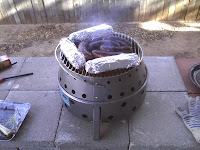
The volcano stove is of course, an outdoor stove as well as a grill.
With the volcano, instead of having your coals exposed, you put the coals in the volcano and slide your camp oven inside.
It can hold a camp oven up to 12 inches wide.
However, apparently using coals in a volcano is completely different from the traditional method.
In other words, the traditional coal chart does not apply, due to the shape and design of the volcano.
It distributes heat along the sides of the camp oven, and is more fuel efficient; therefore the number and placement of coals, is not the same.
I've been reading the volcano cookbook and technical manual which attempts to explain the differences, and trying to make heads or tails of it, for months now. It's very confusing for the lay person.
What I CAN get from it is, you don't need top heat unless you're baking or browning*, and you use less coals than you normally would.
*After trying it out for myself, I'm going to disagree with the "no top heat needed" claim. Yes, you need top heat. Unfortunately, there's no information on how many coals on top vs bottom.
I also get that you can control the heat by opening and closing the vents. Open is hottest, 50% is middle, and closed is least hot.
There's also a "center plate" that you can use or not use*, that diffuses heat for lower temperatures**.
*Apparently, you do need the center plate when cooking with coals. You put the coals, and the camp oven, ON the center plate.
**The plate is used as a heat diffuser when you're using propane, and as a base when you're using charcoal.
But there's no coal temperature chart at all. No way to convert recipes from traditional coal placement, to placement of coals in the volcano.
So I contacted the company in an attempt to get some real info that I can possibly use.
What they could tell me was, for a 12 inch camp oven, 350 degrees (or medium heat) is about 13 coals on bottom*; none on top, unless baking or browning.
*This number is assuming you put the coals on the CENTER PLATE, not on the very bottom of the stove. I figured that out, when 13 coals
barely reached 200 degrees.
**This is also subject to adjustment for altitude. Buy an infrared thermometer and check yourself.
***Yes, you do need top heat, based on my experience.
But what about for smaller camp ovens? The book says to place the coals on the center plate for smaller ovens, but not how many to use.
What about deep camp ovens? Do you use the same amount of coals as for standard sized camp ovens?
And what if you're baking or browning? How many coals on top vs. how many on bottom?
When I asked about specific information, they told me to "just experiment".
That's great if you've already mastered the traditional method of coal cooking, and know what you're doing.
But frankly... "Forget everything you've learned-- this is completely different. We can't tell you what the new method is exactly. Figure it out," will certainly frustrate and discourage the average consumer.
So the best I can tell you is, there are cookbooks* and recipes online, that are specifically for the camp oven used in the volcano**.
*Actually, two cookbooks that I know of: The technical manual I've already mentioned, and "volcano magic".
**The dutch oven cookbooks by Colleen Sloan, such as Log Cabin Grub, have some recipes that tell you the coals needed if you're using a volcano.
Either use those recipes, or just use recipes calling for a standard 12 inch camp oven at 350 degrees-- or "medium heat"-- and use about 13 coals*, on the CENTER PLATE.
*Subject to adjustment for altitude. Use an infrared thermometer to monitor temperature.
As there's a lot of hype all over the internet about how great the volcano is, I'm probably going to get some flak for posting this article, as I did the first one.
But as I've said before, this blog was never meant to be "hype" or "advertising".
I post my personal experience exactly as it happened, and if it's not perfect, then it's just not.
***UPDATE: They later got back to me with some more solid info.
25% less coals than you would normally put on top, and put them all on bottom.
In other words, for a 12 inch oven, normally 16 on top and 8 on bottom, based on the traditional coal chart; Put 12 or 13, on bottom only.
None on top unless baking or browning*, in which case you would use about 80% less total coals, distributed 2/3 on top and 1/3 on bottom.
*I disagree. Use top heat all the time.
In other words, for a 12 inch oven, normally 16 on top and 8 on bottom; Put 13 on top, 5 on bottom.
Then I found a boy scout resource that said, for an 8 inch oven, use 8 to 10 coals on the bottom for medium heat; For a 10 inch, 9 to 11 coals; and for 12 inch, 10 to 12 coals.
That resource corroborates with the info I was given. So, now I have something we can work with here.
Please note, this amount of coals assumes you are putting the coals on the CENTER PLATE, not the bottom.














